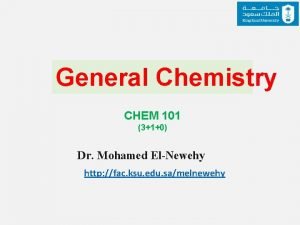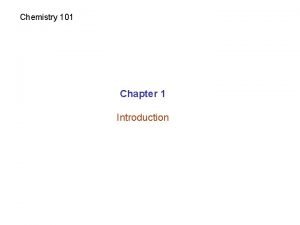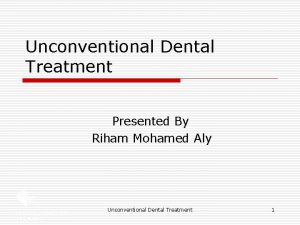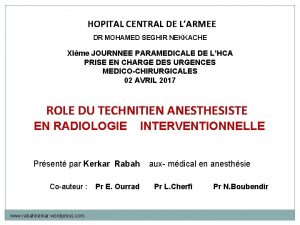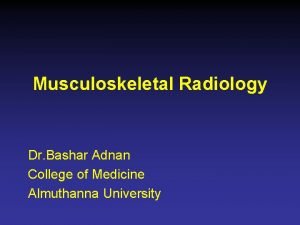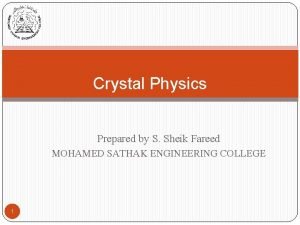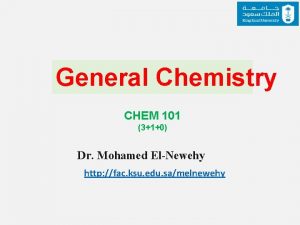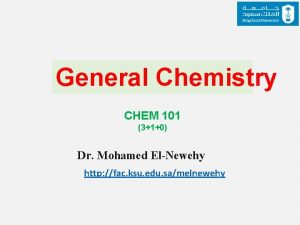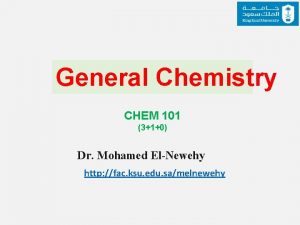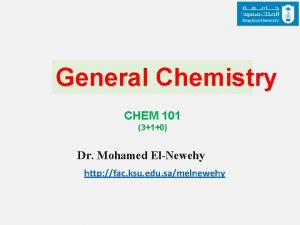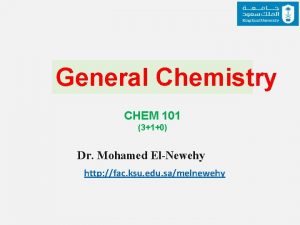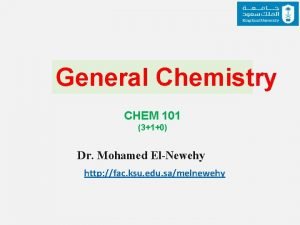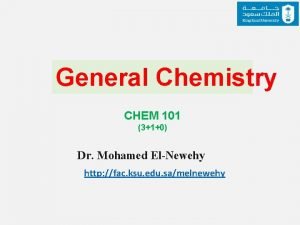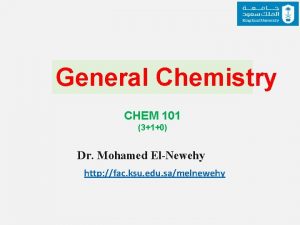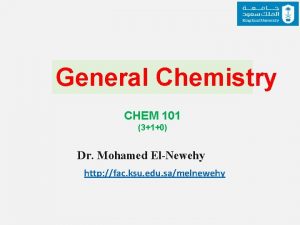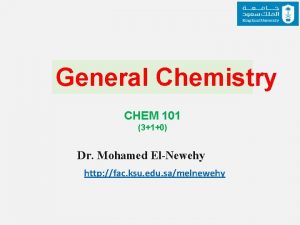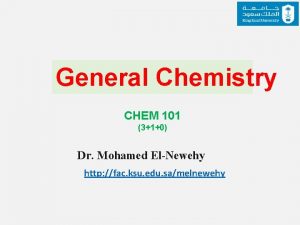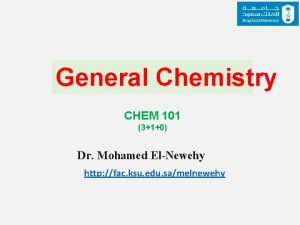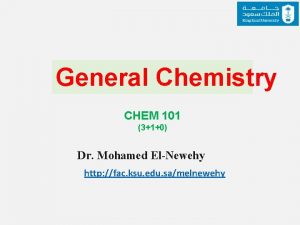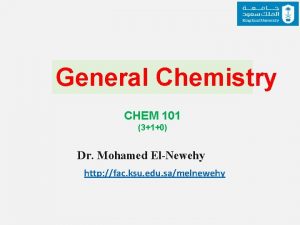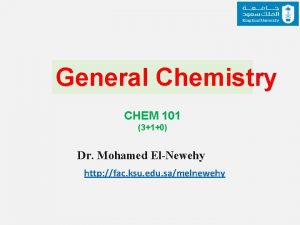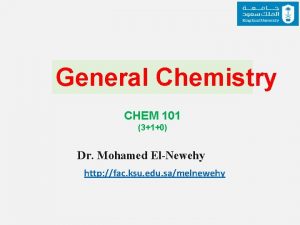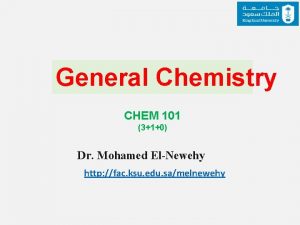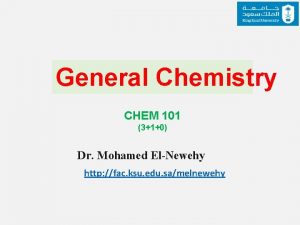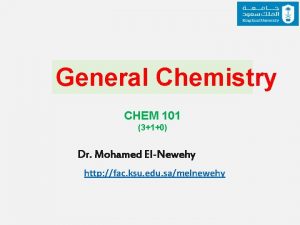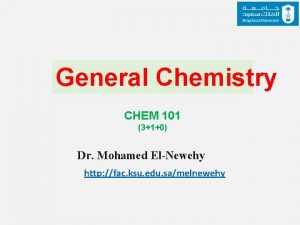General Chemistry CHEM 101 310 Dr Mohamed ElNewehy







































- Slides: 39

General Chemistry CHEM 101 (3+1+0) Dr. Mohamed El-Newehy http: //fac. ksu. edu. sa/melnewehy

Chapter 5 Gases

Substances That Exist as Gases Elements that exist as gases at 250 C and 1 atmosphere o Ionic compounds do not exist as gases at 25°C and 1 atm. because electrostatic forces between cations and anions. o Molecular compounds is more varied. Gases; CO, CO 2, HCl, NH 3, and CH 4 (methane). The majority are liquids or solids at room temperature.

Substances That Exist as Gases

Substances That Exist as Gases Physical Characteristics of Gases o Gases assume the volume and shape of their containers. o Gases are the most compressible state of matter. o Gases will mix evenly and completely when confined to the same container. o Gases have much lower densities than liquids and solids. NO 2 gas

Pressure of a Gas SI Units of Pressure o Velocity is the change in distance with elapsed time. velocity = distance moved elapsed time m/s or cm/s o Acceleration is the change in velocity with time. acceleration = change in velocity elapsed time m/s 2 (or cm/s 2 ) force = mass x acceleration SI unit of force is the newton (N), where 1 N = 1 kg m/s 2

Pressure of a Gas SI Units of Pressure o Pressure as force applied per unit area: Force Pressure = Area Units of Pressure 1 pascal (Pa) = 1 N/m 2 1 atm = 760 mm. Hg = 760 torr 1 atm = 101, 325 Pa

Pressure of a Gas Atmospheric Pressure 10 miles 4 miles Sea level 0. 2 atm 0. 5 atm 1 atm

Pressure of a Gas Atmospheric Pressure How is atmospheric pressure measured? o The barometer is probably the most familiar instrument for measuring atmospheric pressure. o Standard atmospheric pressure (1 atm) is equal to the pressure that supports a column of mercury exactly 760 mm (or 76 cm) high at 0°C at sea level.

Pressure of a Gas Atmospheric Pressure

Pressure of a Gas Atmospheric Pressure

The Gas Laws The Pressure-Volume Relationship: Boyle’s Law Boyle’s law, states that the pressure of a fixed amount of gas at a constant temperature is inversely proportional to the volume of the gas. P a 1/V P x V = constant P 1 x V 1 = P 2 x V 2 Constant temperature Constant amount of gas

The Gas Laws Apparatus for Studying the Relationship Between Pressure and Volume of a Gas As P (h) increases V decreases

The Gas Laws A sample of chlorine gas occupies a volume of 946 m. L at a pressure of 726 mm. Hg. What is the pressure of the gas (in mm. Hg) if the volume is reduced at constant temperature to 154 m. L? P x V = constant P 1 x V 1 = P 2 x V 2 P 1 = 726 mm. Hg P 2 = ? V 1 = 946 m. L V 2 = 154 m. L P 1 x V 1 726 mm. Hg x 946 m. L P 2 = = = 4460 mm. Hg 154 m. L V 2

The Gas Laws The Temperature-Volume Relationship: Charles’s and Gay-Lussac’s Law Variation in Gas Volume with Temperature at Constant Pressure As T increases V increases

The Gas Laws The Temperature-Volume Relationship: Charles’s and Gay-Lussac’s Law Charles’s law, states that the volume of a fixed amount of gas maintained at constant pressure is directly proportional to the absolute temperature of the gas. Variation of Gas Volume with Temperature at Constant Pressure Va. T V = constant x T V 1/T 1 = V 2 /T 2 Temperature must be in Kelvin T (K) = t (0 C) + 273. 15

The Gas Laws A sample of carbon monoxide gas occupies 3. 20 L at 125 0 C. At what temperature will the gas occupy a volume of 1. 54 L if the pressure remains constant? V 1 /T 1 = V 2 /T 2 V 1 = 3. 20 L V 2 = 1. 54 L T 1 = 398. 15 K T 2 = ? T 1 = 125 (0 C) + 273. 15 (K) = 398. 15 K V 2 x T 1 T 2 = = V 1 1. 54 L x 398. 15 K 3. 20 L = 192 K

The Gas Laws The Volume-Amount Relationship: Avogadro’s Law Avogadro’s law, states that at constant pressure and temperature, the volume of a gas is directly proportional to the number of moles of the gas present. V a number of moles (n) V = constant x n V 1 / n 1 = V 2 / n 2 Constant temperature Constant pressure

The Gas Laws The Volume-Amount Relationship: Avogadro’s Law Ammonia burns in oxygen to form nitric oxide (NO) and water vapor. How many volumes of NO are obtained from one volume of ammonia at the same temperature and pressure? 4 NH 3 + 5 O 2 1 mole NH 3 4 NO + 6 H 2 O 1 mole NO At constant T and P 1 volume NH 3 1 volume NO

The Ideal Gas Equation Boyle’s law: P a 1 (at constant n and T) V Charles’ law: V a T (at constant n and P) Avogadro’s law: V a n (at constant P and T) Va n. T P n. T V = constant x =R P P R is the gas constant PV = n. RT

The Ideal Gas Equation The conditions 0 0 C (273. 15 K) and 1 atm are called standard temperature and pressure (STP). Experiments show that at STP, 1 mole of an ideal gas occupies 22. 414 L. PV = n. RT (1 atm)(22. 414 L) PV R= = n. T (1 mol)(273. 15 K) R = 0. 082057 L • atm / (mol • K) An ideal gas is a hypothetical gas whose pressure-volume-temperature behavior can be completely accounted for by the ideal gas equation.

The Ideal Gas Equation What is the volume (in liters) occupied by 49. 8 g of HCl at STP? T = 0 0 C = 273. 15 K PV = n. RT V= P P = 1 atm 1 mol HCl n = 49. 8 g x = 1. 37 mol 36. 45 g HCl 1. 37 mol x 0. 0821 V= V = 30. 7 L L • atm mol • K 1 atm x 273. 15 K

The Ideal Gas Equation Argon is an inert gas used in lightbulbs to retard the vaporization of the filament. A certain lightbulb containing argon at 1. 20 atm and 18 0 C is heated to 85 0 C at constant volume. What is the final pressure of argon in the lightbulb (in atm)? PV = n. RT n, V and R are constant n. R P = = constant T V P 1 P 2 = T 1 T 2 P 1 = 1. 20 atm T 1 = 291 K P 2 = ? T 2 = 358 K T 2 358 K = 1. 20 atm x = 1. 48 atm P 2 = P 1 x 291 K T 1

The Ideal Gas Equation

The Ideal Gas Equation

The Ideal Gas Equation Density (d) Calculations PM n = RT V The number of moles of the gas, n , is n= m is the mass of the gas in g m = P RT MV m M M is the molar mass of the gas PM m d= = V RT Molar Mass (M ) of a Gaseous Substance d. RT M= P d is the density of the gas in g/L

The Ideal Gas Equation A 2. 10 -L vessel contains 4. 65 g of a gas at 1. 00 atm and 27. 0 0 C. What is the molar mass of the gas? d. RT M= P 2. 21 M= g L M = 54. 5 g/mol 4. 65 g m = = 2. 21 d= V 2. 10 L x 0. 0821 L • atm mol • K 1 atm x 300. 15 K g L

The Ideal Gas Equation


The Ideal Gas Equation


Dalton's law of Partial Pressures Dalton’s law of partial pressures, states that the total pressure of a mixture of gases is just the sum of the pressures that each gas would exert if it were present alone. V and T are constant

Dalton's law of Partial Pressures Consider a case in which two gases, A and B, are in a container of volume V. n. ART PA = V n. A is the number of moles of A n. BRT PB = V n. B is the number of moles of B PT = PA + PB PA = XA PT n. A XA = n. A + n. B XB = n. A + n. B PB = XB PT Pi = Xi PT mole fraction (Xi ) = ni n. T

Dalton's law of Partial Pressures A sample of natural gas contains 8. 24 moles of CH 4, 0. 421 moles of C 2 H 6, and 0. 116 moles of C 3 H 8. If the total pressure of the gases is 1. 37 atm, what is the partial pressure of propane (C 3 H 8)? Pi = Xi PT PT = 1. 37 atm 0. 116 Xpropane = 8. 24 + 0. 421 + 0. 116 = 0. 0132 Ppropane = 0. 0132 x 1. 37 atm = 0. 0181 atm

Dalton's law of Partial Pressures

Dalton's law of Partial Pressures Collecting a Gas over Water 2 KCl. O 3 (s) 2 KCl (s) + 3 O 2 (g)

Dalton's law of Partial Pressures o Gas does not react with water and that it is not appreciably soluble in it. o Oxygen gas is ok, but not for gases such as NH 3. o The oxygen gas collected in this way is not pure, however, because water vapor is also present in the bottle. o The total gas pressure is equal to the sum of the pressures exerted by the oxygen gas and the water vapor: PT = PO 2 + PH 2 O

Dalton's law of Partial Pressures Vapor of Water and Temperature

Dalton's law of Partial Pressures
 101 310
101 310 Chem 101
Chem 101 Chemistry 101 chapter 1
Chemistry 101 chapter 1 Riham mohamed aly
Riham mohamed aly Mohamed dahoui
Mohamed dahoui Lodacain
Lodacain Mohamed kossentini
Mohamed kossentini Mohamed homayed death
Mohamed homayed death Discovering computer
Discovering computer Mohamed el merouani
Mohamed el merouani Hopital mohamed seghir nekkache
Hopital mohamed seghir nekkache Dr. mohammad diab
Dr. mohammad diab Yahye mohamed omar
Yahye mohamed omar Dr nasser mohamed
Dr nasser mohamed Dr mohamed eldeib
Dr mohamed eldeib Power rating
Power rating Bouhicha
Bouhicha Abdelrahman mohamed
Abdelrahman mohamed Dr mohamed bashar shala
Dr mohamed bashar shala Dr mohamed bashar shala
Dr mohamed bashar shala Mohamed salah
Mohamed salah Mohamed akel
Mohamed akel Mohamed akel
Mohamed akel Mohamed akel
Mohamed akel Mohamed zahran nyu
Mohamed zahran nyu Mohamed taamouti
Mohamed taamouti Mohamed zahran nyu
Mohamed zahran nyu Mohamed merchant
Mohamed merchant Mohamed akel
Mohamed akel Hassan fareed physics
Hassan fareed physics Mohamed younis umbc
Mohamed younis umbc Mr mohamed chafik el idrissi
Mr mohamed chafik el idrissi Mohamed hmiden
Mohamed hmiden How many wives muhammad had
How many wives muhammad had Orhán
Orhán Omar requirements
Omar requirements Dr mohamed nasr
Dr mohamed nasr Al fayed
Al fayed Mohamed samir design
Mohamed samir design Soumia ecrit en arabe
Soumia ecrit en arabe
